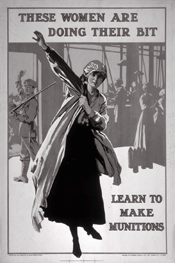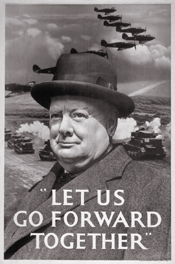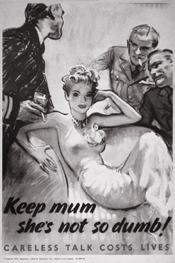- History
- World
The Hoover archives are employed by a constant stream of distinguished scholars, but from time to time, the archives are also employed by scholars who aren't particularly distinguished--yet: Stanford undergraduates. Last winter, for example, Stanford professor of history Peter Stansky organized his seminar in British history around the Hoover Institution's renowned collection of posters. Stansky, who is also honorary curator of the British Labour Collection at the Hoover archives, arranged for his students to pore over hundreds of examples of British posters, then curate a formal exhibit.
The poster collection on which the students worked was assembled by several generations of Hoover archivists over a period of a seventy five years. Some posters still bear traces of glue and paint from the walls on which they were originally plastered. In total, there are over fifty thousand posters from all parts of the globe, including bundles of posters from Europe that have yet to be opened. Posters are by definition intended to sway public opinion during a particular crisis. The posters in the Hoover collection were printed up quickly and designed for maximum impact at the moment. The ephemeral nature of their message often makes interpreting the posters difficult even for well-versed historians.
Professor Stansky's students worked with the Hoover archives' exhibit coordinator, Cissie Hill, who showed the students some three thousand British posters from both world wars. The students then selected some fifty posters to display in the Hoover Exhibit Pavilion next to the Hoover Tower. The exhibit appeared in conjunction with a cultural program, Britain Meets the Bay, sponsored by the British consul general of San Francisco. Since Professor Stansky's students did not want to limit themselves to the fifty or so items that fit in the Exhibit Pavilion, they supplemented their work by using high technology, making more than one hundred additional posters available on an Internet web site (http://www leland.stanford.edu/class/history245s). Whereas several thousand viewers saw the students' work in the Hoover Exhibit Pavilion, the number who saw the students' work on the World Wide Web reached into the tens of thousands.
A sampling of the posters placed on display:
 Charming colors of lavender and yellow make an image of a young woman going off to the factory appear stylish and appealing. She pulls on her work apron as though it were a silk coat. War work helped ignite the women's suffrage movement, with lasting political consequences. Charming colors of lavender and yellow make an image of a young woman going off to the factory appear stylish and appealing. She pulls on her work apron as though it were a silk coat. War work helped ignite the women's suffrage movement, with lasting political consequences. |
 By World War II, highly romanticized images were no longer possible. Instead, a resolute Churchill announces simply "Let us go forward together." By World War II, highly romanticized images were no longer possible. Instead, a resolute Churchill announces simply "Let us go forward together." |
 British troops were to keep military secrets even from beautiful enemies: "Keep mum, she's not so dumb!" British troops were to keep military secrets even from beautiful enemies: "Keep mum, she's not so dumb!" |







